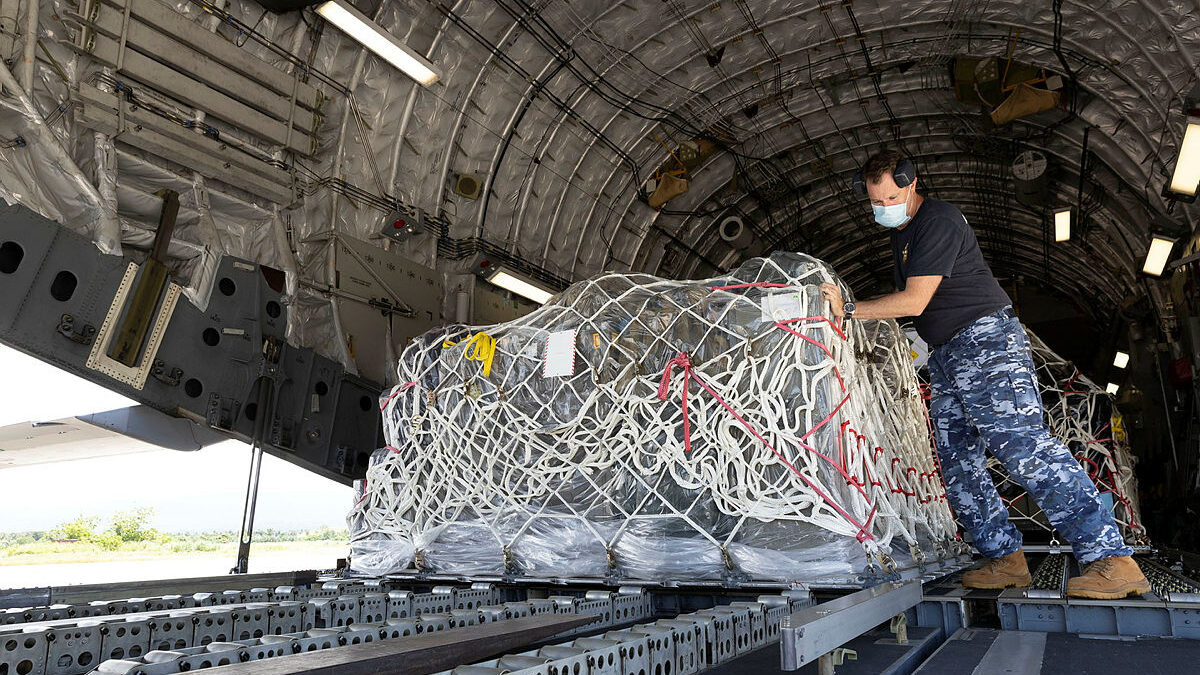
Royal Australian Air Force aviator Sergeant Adam Dumstone unloads supplies from a C-17A Globemaster III aircraft during Operation Lilia at Honiara international airport, Solomon Islands on Feb. 13, 2022.
SYDNEY: It’s a corny line, akin to the one about American companies being born in someone’s garage, but Australia is launching a media campaign to help boost its defense industry, called “in your own backyard.”
“We must be able to build what we need at home to defend ourselves when we need it and the COVID-19 pandemic has shone a light on just how critical that is,” Melissa Price, minister for defence industry, said in a Monday release unveiling the new push. “We want Australians to understand that there are and will continue to be incredible opportunities for skilled people within our defence industries and that will continue for many years to come.” The campaign will be featured here on television, radio and social media.
“The campaign highlights that the skills Australians have displayed for generations building ‘stuff’ in their backyards are now in great demand to fill the jobs in our growing defence industries, which supply the Australian Defence Force with the products and services it needs to protect Australia and its national interests,” the release said.
But just because it sounds a bit corny doesn’t mean it’s not substantive.
Robbin Laird, an American defense consultant with a deep knowledge of Australian defense issues, said the initiative takes place within a broad shift in Australian strategy that really started in 2018 when the country decided it needed “to become more self-reliant,” well before COVID-19 struck. Price noted in the statement about the campaign that the pandemic has only strengthened the government’s belief that Australia must not rely overmuch on others.
Laird said this reflects a deep belief in the Australian defense establishment that “you need a whole of society response” to China, Russia and the other autocratic governments that threaten the liberal world order.
That would include mobilization “to get universities and other elements of the country involved, not just people in uniform,” he said. “You all have your bit to do,” is the message he says the government is sending.
Australian Defense Catalog Offers ‘Creative’ Opportunities: Expert
In a separate release, the Australian defense ministry launched the sixth iteration of its unique arms export catalog, a surprising move to close arms market watchers.
“I don’t recall seeing any public-releasable source of similar information as comprehensive as the Australian Defence Sales Catalogue,” Frank Cevasco, an arms export expert who runs a private consultancy, said in an email. “More importantly, the catalogue will be absolutely invaluable to those governments and industries exploring ‘creative’ alternatives to defense acquisition, among those are: partnering on new programs with the Australian government, partnering with Australian industry, selling to Australia, or acquiring Australian products or services.”
Laird said he believed the catalogue provides the Lucky Country with the chance to make sales without always involving large American defense contractors. Australia is partnered with the US on the AUKUS nuclear attack submarine program and the F-35 — among other programs — but a common refrain in private here is that, while the alliance with America is crucial, it must not become suffocating.
Combing through the catalog, every weapon listing indicates whether it is subject to ITAR restrictions. The International Traffic in Arms Regulations stem from American laws governing weapons sales of items on the US Munitions List. A key restriction in most US arms sales is that sales to third parties are either forbidden or must be approved by the US.
Meanwhile, in the far north, a symbol of the US-Australia partnership is about to begin. US Marines and Army solders are arriving in Darwin for the eleventh iteration of the Marine Rotational Force – Darwin (MRF-D).
It will mark, according to an Australian Defense Ministry release, the first time US Army soldiers have taken part in these exercises. A US embassy release from Canberra says the troops are “a detachment from the U.S. Army Pacific to support joint and combine interoperability with the Marines and ADF.”






















